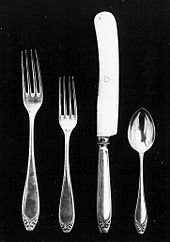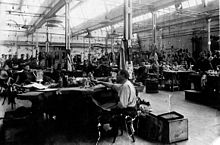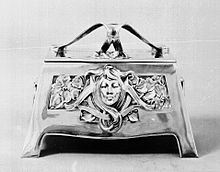Silver goods factory Peter Bruckmann & Sons
The Peter Bruckmann & Sons silver goods factory was a silver goods factory founded in Heilbronn in 1805 . The company's artistic products, especially tableware, established a reputation for the company, which has been family-owned for four generations, well beyond Heilbronn. Peter Bruckmann , a grandson of the founder and co-owner of the company from 1887 to 1923, was chairman of the Deutscher Werkbund .
history
The silver goods factory was founded by Georg Peter Bruckmann (1778–1850) in 1805 on the market square in Heilbronn as the successor to the silversmiths of his father Johann Dietrich Bruckmann (1736–1807) and moved in 1809 to 19 Allerheiligenstrasse. The early products included silver patent spoons, pipe bowls, shoe buckles and spurs. In 1810, Bruckmann used self-made steel stamps for the first time in Germany to emboss silver goods. The company's products were exhibited at the trade fairs in Frankfurt and Leipzig and soon became known nationwide. The artistic direction of the company was from 1819 to 1821, later academy professor Conrad Weitbrecht . During this time, the first larger silver goods press was installed at Bruckmann in 1820. Until 1830, the company was the only precious metal processing company in Heilbronn that was allowed to use the designation factory . From 1839, metal processing machines from Alfred Krupp were used at Bruckmann . In order to train skilled young talent, founder Georg Peter Bruckmann donated 10,000 guilders in 1842 to establish a modeling and drawing school in Heilbronn. The founder also campaigned for the standardization of metal alloys based on the French and English models and for the creation of a law for the protection of designs.
After the founder's death, his widow continued the business with their son Wolfgang Peter Bruckmann (1818–1891), who had been trained as a goldsmith and silversmith by Clavel in Geneva. In 1851 the founder's younger son, Ernst Dietrich Bruckmann (1829–1870), also joined the company. Ernst Dietrich had enjoyed an agricultural education and spent a long time in North America as a settler. He hadn't been scheduled to join his parents' company, but his mother appreciated his life experience in North America. In his father's business, he primarily tried to improve the production facilities and concentrate production on so-called Alfénide cutlery . After his early death, his widow Pauline, nee. Braun, who later married the Reichstag member Georg Härle , took over the management together with brother-in-law Wolfgang Peter Bruckmann. In 1887 Ernst Dietrich Bruckmann's son Peter Bruckmann (1865–1937) joined the management team, two years later his brother Ernst. The factory flourished under this generation of entrepreneurs. The brothers were able to steadily expand the business, so that in 1898 they had to move into a new building in Lerchenstrasse in Heilbronn, which employed 700 people. The focus of the production was on real silver tableware and cutlery as well as silver-plated cutlery. The facility on Lerchenstrasse was described as the largest and most modern German silver goods factory.
In 1907, Peter Bruckmann & Söhne signed the appeal for the foundation of the Deutscher Werkbund.
After 1923 the company passed to the fourth generation of the family. The plant was almost completely destroyed in the air raid on Heilbronn on December 4, 1944 and in the fighting for Heilbronn in April 1945. With the selfless commitment of the workforce, however, a production facility could be set up again at the same place, which (partly producing outdoors) was already producing the first cutlery in September 1945. Another 500 people were employed within a year.
Under Peter Bruckmann's son Dietrich Bruckmann (1896–1967), owner since 1937, after the Second World War it was possible to rejoin competing companies that had not suffered any damage during the war. Dietrich Bruckmann in 1955 for his progress over the first Heilbronner citizens with the Great Cross of Merit awarded.
After Dietrich Bruckmann's death, the company was sold in 1968 to the Dutch company Gerofabriek NV , which relocated the headquarters to Neckarsulm in 1970 , reduced the workforce and filed for bankruptcy in 1973.
After the bankruptcy, the silver manufacturer Gebrüder Reiner (Krumbach) bought cutlery such as B. Empire and Rococo , taken over and integrated into their program.
Individual evidence
- ↑ Chronology of the DWB at www.werkbund-archiv.de. Retrieved September 13, 2011
- ^ Company history on the website of Gebrüder Reiner GmbH & Co. KG. Retrieved September 23, 2011
literature
- Kurt Erhard von Marchtaler: Georg Peter Bruckmann (1778–1850) and his sons. In: Swabian Life Pictures. Volume 4. Kohlhammer, Stuttgart 1948, pp. 15-31.
- Robert Bauer: Heilbronn diary sheets. Self-published, Heilbronn 1949.
- Helmut Schmolz , Hubert Weckbach: Heilbronn. History and life of a city. 2nd, improved and enlarged edition. Konrad, Weißenhorn 1973, ISBN 3-87437-062-3 .
- Karlheinz Fuchs (Red.): Silver from Heilbronn for the world. P. Bruckmann & Sons (1805–1973) (= Heilbronn museum catalog . No. 96). Städtische Museen Heilbronn, Heilbronn 2001, ISBN 3-930811-90-1 .


